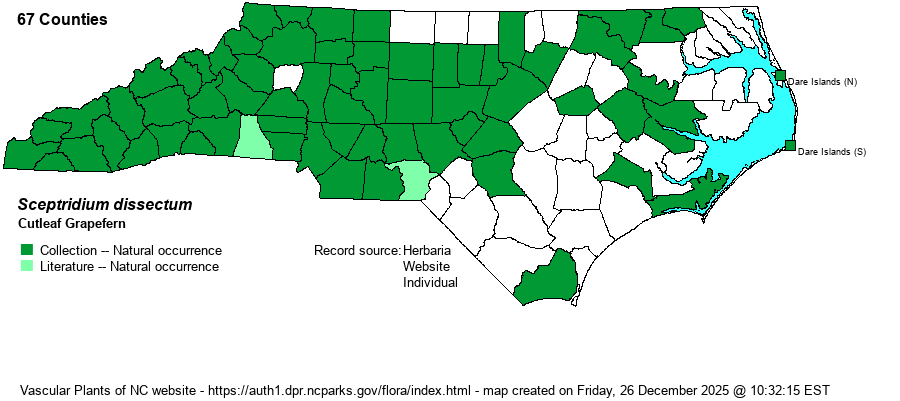| Section 2 » Family Ophioglossaceae |
Show/Hide Synonym
| taxonName | relationship | relatedTaxonName | relatedTaxonRefText | relComments |
|---|
|
|
| Sceptridium dissectum | = | Botrychium dissectum | | | | Sceptridium dissectum | = | Botrychium dissectum | Gleason and Cronquist (1991) | | | Sceptridium dissectum | = | Botrychium dissectum | Flora of North America (1993b, 1997, 2000, 2002a, 2002b, 2003a, 2004b, 2005, 2006a, 2006b, 2006c, 2007a, 2009, 2010) | | | Sceptridium dissectum | = | Botrychium dissectum | Kartesz (1999) | | | Sceptridium dissectum | = | Botrychium dissectum | | | | Sceptridium dissectum | = | Botrychium dissectum | Radford, Ahles, and Bell (1968) | | | Sceptridium dissectum | = | Botrychium dissectum | Wofford (1989) | | | Sceptridium dissectum | = | Botrychium dissectum | Flora of West Virginia | | | Sceptridium dissectum | < | Botrychium dissectum var. dissectum | Fernald (1950) | (also see S. oneidense) | | Sceptridium dissectum | > | Botrychium dissectum var. obliquum | Gleason (1952) | | | Sceptridium dissectum | > | Botrychium dissectum var. dissectum | Gleason (1952) | | | Sceptridium dissectum | > | Sceptridium dissectum var. dissectum | | | | Sceptridium dissectum | > | Sceptridium dissectum var. obliquum | | | | Sceptridium dissectum | > | Botrychium dissectum | Small (1933, 1938) | | | Sceptridium dissectum | > | Botrychium obliquum | Small (1933, 1938) | | | Sceptridium dissectum | < | Botrychium dissectum | Wunderlin & Hansen Flora of Florida (3) | | | Source: Weakley's Flora |
|
| Author | (Sprengel) Lyon | |
| Distribution | Throughout the Mountains and Piedmont; in the Coastal Plain mainly in the northern and east-central counties, very scarce in the southern counties, the Sandhills, and also in some far northeastern ones.
Ranges from southeastern Canada to southern GA, LA, and eastern TX. | |
| Abundance | Common in the Mountains; common in the western and central Piedmont, but only fairly common in the northeastern Piedmont; uncommon to fairly common in the northern parts of the Coastal Plain, but quite rare in most of the southern portions. | |
| Habitat | This species grows in rich to mesic forests, such as bottomland forests, forested slopes, and in thickets. Habitat differences between this species and the very similar S. biternatum are not obvious, perhaps adding to the confusion between these species. |
| Phenology | Fruits from August to October. | |
| Identification | This species and S. biternatum are quite similar and are often confused -- not only in the field but as herbaria specimens as well, owing in part to the form obliquum of S. dissectum looking quite similar to S. biternatum. Each species is widespread in the state, and each has a height of about 1-1.5 feet with leathery sterile blades. Each has this blade triangular in shape and about 5-6 inches long and wide, with the blade having a long petiole/stalk that joins the stipe very near the ground surface. S. dissectum has the fertile blade mostly tripinnate (or more), whereas S. biternatum has the fertile blade only bipinnately cut. In S. biternatum, the "ultimate blade segments mostly oblong to obliquely lanceolate, the margins nearly parallel, the base cuneate, the apex relatively blunt" (Weakley 2018). In S. dissectum, the "ultimate blade segments trowel-shaped, the margins usually not parallel, the base truncate or obtuse, the apex relatively pointed". Thus, visually, S. biternatum blades have the many fewer pinnules nearly parallel-sided (oblong) and with a rounded tip; S. dissectum has typically more heavily-cut leaves, but even if not, the pinnules are strongly triangular and have somewhat pointed tips. Both have the fertile blade quite small and held high above the sterile blade, on a stalk often 8 inches tall or more. | |
| Taxonomic Comments | This species was formerly named as Botrychium dissectum. Many references list varieties of this species, though Weakley (2018) only considers the obliquum taxon and the dissectum taxon as forms and not as varieties.
| |
| Other Common Name(s) | Dissected Grapefern | |
| State Rank | S5 | |
| Global Rank | G5 | |
| State Status | | |
| US Status | | |
| USACE-agcp | FAC link |
| USACE-emp | FAC link |

